#autism article
Explore tagged Tumblr posts
Text
Autism (Non-stereotypical) vs Autism (Stereotypical)

Neurodivergent Insights
#autism#actually autistic#non-stereotypical#stereotypical#differences#similarities#neurodivergence#neurodiversity#actually neurodivergent#feel free to share/reblog#Neurodivergent Insights (Article)
767 notes
·
View notes
Text





Jackie article of all time
#yellowjackets#jackie taylor#lu rambles#It also makes me feel so vindicated because hah!#pre crash jackie is more femme on purpose because shes dressing for others not herself!#hah shes not a mean girl!#and hah! bonus points for jackie autism on imitating how to be a Normal Person!#i have mentioned this on the lottielee server but i dont think ive posted it here before#seriously its such a great article when it comes to understanding jackie
222 notes
·
View notes
Text
sometime I genuinely wonder what it's like to not have autism. if it was possible I would love to see how the world operates as a neurotypical person for one day. even if it was only for one day, atleast I would know what it's like.
#seeing that NPR article made me sad#im going to read it when im in a better headspace but yeah :(#anyways#autism#autistic#actually autistic
82 notes
·
View notes
Text

Neyaphem….nephilim……thinking very hard here
#cal.txt#yes I still read Wikipedia articles for my interests I have autism#X-men#nightcrawler#spn#jack kline#neyaphem#nephilim#……tomato tomato
49 notes
·
View notes
Text
any other autistic people feel like over the counter pain medication doesn't work for them? like tylonel does nothing for me and ibeprophen has almost no effect, but maybe im imagining it?
edit: i made a poll ↓
#autism can affect how medications affect you and jt has been researched with stimulant ADHD meds#i tried looking up if any one had done any research on this but i only found stupid articles about tylonel causing autism#thanks ableism#autism#autistic#nuero punk#auti punk#autipunk#level 2 autism#nueropunk#asd#disability#level 1 autism#level 3 autism#autistic things#nuerodiversity#nuerodivergent#autism acceptance#please tell me im not just imagining this
171 notes
·
View notes
Text
hey do oyu guys want my article i wrote about cannibalism in 8th grade
if not i have articles on bees, dinosaurs, snakes and sharks too
#dinosaur article is unfinished#so is shark article#very sorry#i did not autism hard enough#to finish them#not firefox related#no idea why i posted this#yeah
21 notes
·
View notes
Text
Walmart customers who experience sensory overload while shopping now have their own sensory-friendly hours, according to an official press release. Sensory-friendly hours launched on July 22, 2023, and will run through August. Most of Walmart’s stores will offer “sensory-friendly shopping hours” every Saturday during this period from 8 a.m. to 10 a.m. — and TikTokers are thrilled by this new initiative. According to Supermarket News, during those sensory-friendly hours, Walmart stores nationwide will replace moving pictures on screens with static images, and a number of locations will turn off music and lower overhead lights to create an environment more friendly to those with autism and other disabilities.
What a fantastic idea that more supermarkets should consider doing.
#sensory issues#sensory processing disorder#sensory overload#walmart#autism#neurodivergence#disability#accommodations#article
194 notes
·
View notes
Text
Annotating tips:
whenever I read an article that's printed out I always mark the page. I remember when I was younger, a lot of people thought the teachers were stupid for saying it, but numbering the paragraphs helps.
I also circle words I don't know and then look them up and define them. even if they're words I know but don't use everyday, a simplified definition is easier to understand.
ill highlight things I think are important, if it's for an assignment then I highlight the answers for each question and number what question it's for before answering the question. (I answer questions at the end)
then I also summarize each paragraph. just to the right of it. so then I don't have to reread the whole thing. it should be a couple words if it's a short paragraph. or one full sentence if it's a long paragraph.
#autism tips#autism#adhd tips#maybe#school advice#school tips#notes#note taking#annotations#annotating#college#university#advice#this is just what helps me#i also started doing it with articles that i want to read in general#imo PAPER IS ALWAYS BETTER THAN DIGITAL#remember to recycle#everything in blue is simply the key details
32 notes
·
View notes
Text
As someone who has always existed on the fringes of society, it may shock people to find that the most destabilising part of my marginalisation that undercut all my identities – being neurodiverse – is the only one I really started to understand well into adulthood. It was the only time I had a name for it, and I could express to people what I meant by it and how it impacted my life. Growing up and understanding that neurodiversity existed beyond white boys who were autistic, Jodie Hare’s Autism is Not A Disease: The Politics of Neurodiversity is a perfect foundational book encouraging us to challenge misconceptions we have on neurodiversity namely autism, through key concepts and her own experiences as an autistic person.
The book opens by highlighting the juxtaposition that exists between the growth of the neurodiversity movement in parallel to a very stagnant understanding of neurodiversity, particularly autism. Hare points out how neurodiversity has started to be weaponised by people who understand it the least, including the state, for their own agendas at the individual, collective and structural levels of society, contributing to ‘the word being stripped of its political potential’.
A misunderstood yet growing movement
Hare’s introduction where she points to the flaws and implications of such rigid understandings and applications of disabilities and neurodivergence resonates especially. Through the retelling of the history of neurodiversity with specific focus on autism, Hare highlights Judy Singer as the propagator of the idea of neurodiversity. I wish Hare had illuminated the present controversies surrounding Singer and how she has deliberately chosen to sideline online autistic communities who not only developed the idea of neurodiversity but also organised around it. What is even more terrifying is Singer’s lack of political consistency as she fails to make the links with the collective struggles of the transgender community and chooses to contribute to their discrimination and the transphobia they face. So whilst Hare is wrong in her illumination that Singer popularised the term neurodiversity from online communities, she is correct in illuminating that Singer was not the first to theorise about and offers alternative beginnings that contributed and moved our understanding of autism – a history I was not even aware of.
Our medicalised understanding of autism in particular can be traced to Eugen Blueler, who coined the term in 1911. Phsyciatrist Leo Kanner built on this foundation, introducing the concept of autism to the world in 1943. Singer’s own contribution was to encourage a paradigm shift in understanding for people with autism and beyond that that their difficulties were not symptoms of disorders or disease: it was not just about having autism versus not having autism, or being normal versus pathological but that there were direct and devastating consequences of living in a world organised to meet the needs of the neurotypical or neuroconformist majority.
Despite ongoing complaints around online spaces enabling self-diagnosis, Hare demonstrates in her book that the significance of internet chatrooms, forums and culture is normal in linking neurodiverse people with one another. Hare highlights through Singer’s own research on the internet that this only further helps strengthen our shared experiences and our calls to liberation for those who do not exist in a neuroconformist reality.
Introducing readers to these foundational concepts, Hare enables her book to be in conversation with more advanced and critical understandings of neurodiversity such as Robert Chapman’s Empire of Normality which highlights the limitations of viewing neurodivergence, in this context autism, as being good or bad. Chapman builds on this by rejecting binarised value based judgments and instead calls for a holistic focus on the impact of autism on our other cognitive functions. For me, this understanding is important because it provides an opportunity for people, at different starting points in understanding their diagnosis or lack of, in relation to the world, to find and demand the resources and support they need – whatever that may look like.
As someone who still does not understand their neurodiversity, it was really important for Hare to introduce ideas of neurodiversity and the framework it exists in away from a pathologilising model because of how limiting definitions and boundaries of neurodivergence are. Which of my mental illnesses make me neurodiverse? Where do these experiences of neurodivergence start, meet and end? How do they interact with one another? Most importantly, what are the implications for me, someone who is already pathologised, in the world?
I found how Hare forces us to think about the language we use within the neurodivergence framework useful, not only because attempts to be politically correct for autistics or more generally disabled people (i.e. the use of ‘person with autism’ or ‘person with disability’ respectively) end up contributing to disableist discrimination and ironically pathologise them even more by their experiences into a disease.
Neurodivergence in our other collective struggles
I particularly enjoyed how Hare linked her ideas on the problematic nature of categorising forms of neurodivergence like autism as diseases because it reaffirms my own thoughts towards how biased such categories can be. Many disease categories reflect how the world is organised and binarised, whereas the experience of any disease does not exist in these confines. This is made clear by Hare’s unpacking the political nature of neurodivergence as she explores the discrimination, brutulisation and violent victimisation autistic people face in their lives. Importantly, Hare highlights the unspoken element of the neurodiversity movement – as with many liberation movements – the disproportionate impact of neurodivergence, on people from minoritised communities.
Discrimination is never distributed universally. I wish Hare explored the layers of oppression neurodivergent people, especially autistic people, face in more depth, for example a black women with co-existing disabilities like me. I have often had to over-explain myself to people for being perceived as intense and too direct in my communication – which I find very normal – but have had to learn that these are not accepted in any ‘normal’ social setting.
Hare begins (and I wish she never stopped) dismantle the misconception that autism is only prevalent amongst white men. In doing so, she illustrates the many barriers it creates for anyone who is not white, cisheteromormative, disabled in any other way, a man and especially – neurodiverse in a palatable way to actually get diagnosed (if they want or need it), and receive any support.
Hare asks that we proceed in our campaigning beyond the buzzwords and aesthetics of the neurodiversity campaign by understanding the architecture, function and power of language we use
This is useful for thinking about the next steps Hare hints at, which is refusing to adjust or ‘mask’ our behaviours just to fit into a disableist society – not only because of what it takes away from neurodiverse individuals and their communities but because of the hostility it normalises for them. Rightfully, the message here is that those who are neuroconformist, should meet the rest of us where we are.
Exploiting neurodivergence
In her final chapter, of the book describes how neurodiversity is framed as a ‘superpower’ to be exploited by neoliberalism. This exists directly in tandem with the shame the UK government lauds over disabled people trying (and often failing) to access the support they are entitled to through the welfare systems – rather than solving the problem of our disenfranchisment, as Chapman states, we recreate the same harmful neoliberalism under the guise of performative ‘neuro-inclusivity’.
Hare acknowledges that we have made some progress, but calls for more political urgency as we think about how to reorganise our societies, our cognitive functions and disability in these discussions within the wider neurodiversity campaign. She asks that we are mindful and we proceed in our campaigning beyond the buzzwords and aesthetics of the neurodiversity campaign by understanding the architecture, function and power of language we use, to root our work in the Care Manifesto proposed by the Care Collective in the absence of a well-funded, non-privatised health and social care system, and most importantly that we employ greater nuance in our understanding of autism and neurodiversity more generally. This understanding should be a continuous process, one where we all remain teachable, where we are able to learn and unlearn, re-negotiate everything we know, so autistic people and by extension neurodivergents can live their lives in a better world and be valued as they are.
11 notes
·
View notes
Text
As 2025 dawns on us, I regret to say....
We failed. We failed to make half the children autistic. I know Tumblr makes it LOOK like half the children are autistic but-
#autism#neurodivergent#actually autistic#this is based on a quack saying a decade ago that half of children will be autistic by 2025 because of pesticides#needless to say that has not happened#also someone wrote an article about how if half of children were autistic#society would crumble from all those disabled people needing accommodations#sigh#ableism#ableism tw
9 notes
·
View notes
Text


the new tennant doctor’s sonic screwdriver has part of simm!master’s laser screwdriver. which could mean nothing.
#in an extreme autism moment i instantly recognised that bit on the end as the laser screwdriver before i even read this article in the dwm#i knew instantly it was his.#feeling sooooo normal about this#micah.txt#whoposting
126 notes
·
View notes
Text
I saw this article from Forbes that says those who are autistic are most likely to be LGBTQ. According to the article:
Research suggests that people who have an autism diagnosis or autism traits are more likely to be transgender than the general population. One study found the rate to be two to three times higher in people who have autism. Also, a larger percentage of autistic people reported their gender as being something other than strictly male or female, compared to other people. Examples of gender identities included in that study were bigender, genderqueer, and “other.”
I’ll leave the full the article below in case anyone want to read it:
I personally found this very interesting and I wanted to share it. Especially since it’s LGTQ month. I hope you also find it interesting.
#autism#actually autistic#LGBTQ#lgbtq month#autism & LGBTQ#neurodiversity & LGBTQ#lesbian#gay#transgender#queer#bisexual#feel free to reblog#Forbes article
173 notes
·
View notes
Text
Dr. Egon Splenger being called "a 'New Wave' Mr. Spock" by Harold Ramis

I also found this article:

My autistic radar never fails...
#autistic egon spengler#dr egon spengler#ghostbusters 1984#ghostbusters#canon autistic character#autism#egon spengler#why do I always get obsessed with the autistic one?#no matter fictional characters or celebrities#autistic coded or confirmed autistic#articles
7 notes
·
View notes
Text
Izakaya Kamenoya
I am re-watching the Captain Amagai arc, which I love because it has just a shit-ton of Seireitei slice-of-life worldbuilding. Early in the arc, Kira goes to the bar with Renji and Iba to sob about how his new Third Seat is better than him, and it made me wonder-- do the lieutenants always go to the same bar, or does the anime just make up a new one every time? Episode 172 had a nice shot of the exterior:
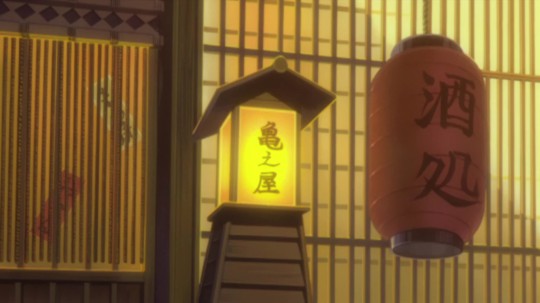
I immediately went to Episode 355 (the second New Year's episode), because I'm always thinking about Rukia shotgunning that beer while Renji gazes on lovingly, and it certainly *looks* like same place, but again, maybe that's just a very standard-looking izakaya.

I decided that trying to translate the kanji might help. They're more visible in the first image. The ones on the paper lantern, 酒処 were easy, because they just say izakaya (literally, "alcohol" and "place"). That just supported the idea that this was just some generic bar. For the kanji on the wooden lantern, which appeared to be the same as the ones on the sign above the door, I managed to puzzle out the bottommost one, 屋, which means "shop" or "restaurant." Hmm.
At this point, I was feeling a little stumped, so I went looking for other screen shots.
Other bar scenes I could remember took place in: Episode 179 (Ukitake and Kyouraku try to angle Amagai into a threesome). This had a clearer shot of the sign, and it's definitely the same as the lantern.

Ep 305 (Kira and Hisagi go for drinks after work and run into Unohana having "Ladies' Night" with Soi Fon, the Kotetsu sisters, and Yachiru ????)
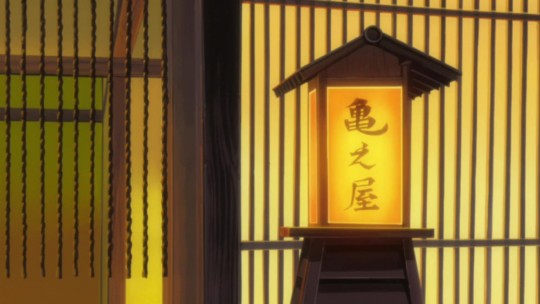
And finally, Episode 265 (the end of the Sword Beasts arc, Ladies' Night again, I guess, this time with zanpakutou)
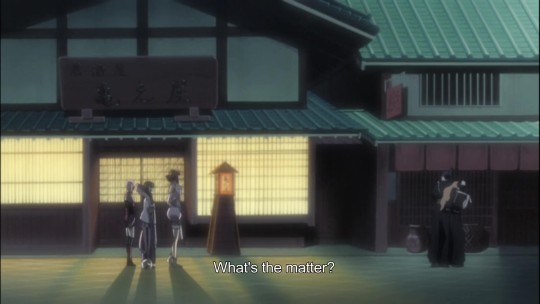
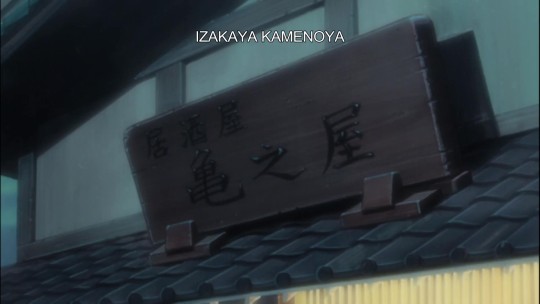
and bingo, they actually translated it for me, this time!!
In, the only one that didn't turn out to take place at Izakaya Kamenoya was from Ep. 303, the first New Year's episode. The SWA holds their holiday luncheon here (the sign says 茶屋, or "tea house") .
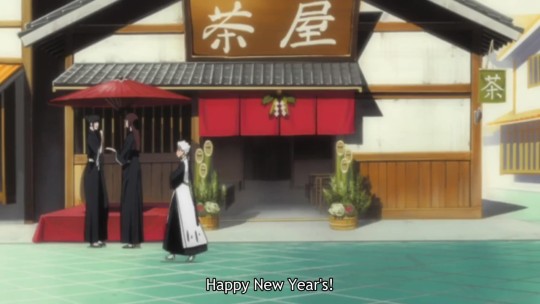
It is also not the place where Rukia and Renji announce their engagement in WDKALY, that place is called Safflower, and it's fancier and it's specifically mentioned that it's way classier than everyone's usual digs.
That's neither here nor there, let's get back to Izakaya Kamenoya!
Later on, like when I was 90% of the way through writing this post, I realized there was an earlier shot of the sign in episode 172 that was also translated (which I thought I remembered and then assumed I had hallucinated when I couldn't find it, but it was from a separate trip to bar with Kibune and Kira's shitty subordinates). Conveniently, it's also probably the most readable out of all of them. EDIT: I didn't notice when I pasted this in here, but they translate it as Kamegameya here, which seems like a mistake? B3 suggests they might have read the second character as a repetition (with the k turning into a g, which I don't know all the details of, but I assume it's that thing that happens in Japanese when a word is in the interior of another word and it gets a harder consonant, the same way the s in "sakura" in Senbonzakura becomes a z). Google also tells me that the name of Yugi's grandfather's game shop in Yu-Gi-Oh is called Kame Game, so I wonder if the subtitler here was just working on muscle memory 😂. I'm sticking with Kamenoya, although Turtle Turtle Bar has its own charm)
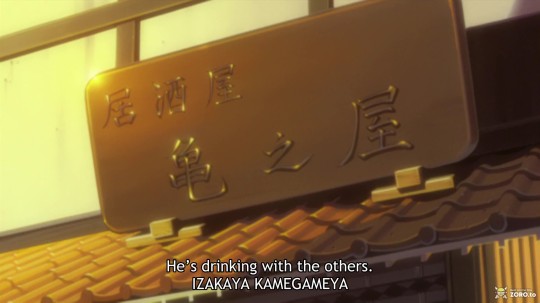
The three characters in the upper left are 居酒屋, which is just a different way to spell izakaya.
"Kame" was easy to translate, it's the leftmost large character on the sign, 亀. It means "turtle", but the second meaning is "heavy drinker," so I'm guessing this might be a bit of a pun. Unfortunately, googling didn't turn up any further detail on this.
I puzzled a little over the middle character, until I realized that it might be 之, which is an older version of の. Oh, says me, who only speaks the Japanese I picked up from anime, it's Kame no ya, the way all the inns in Kakuriyo end in "ya." It just means "House of the Turtle", or "Turtle's Pub."
Turtle's Pub. Can we just take a moment to reflect on the fact that the lieutenants (and sometimes captains) like to hang out at someplace called Turtle's? I am so charmed by this. I have not been so excited since the time I realized that Renji was wearing the koi hoodie in the Bount Arc OP.
It's possible that it was just named by a guy who has "kame" as part of his name or who likes turtles, or as I said, maybe it's a pun, but there are two other possibilities I thought of:
In line with this post on the naming scheme for the Seireitei Gates, perhaps it's in the north part of the city, and named after Genbu the Black Tortoise-Snake
When I am making up business names in my fanfic, I often like to associate them with the squads they are near-- dragons for stuff near Squad 10, fish for 13, firebirds for things that are more city-wide. It's partially trying to tap into squad solidarity, and partially so people have a clue where your place is located in this stupid maze city. I love the idea of some former captain with a turtle-themed zanpakutou, whose is fondly remembered because someone happened to name a good bar after them.
I looked up that extremely questionable Blood War era Seireitei map, wondering if maybe Squad 3 was near the north gate:

It turns out it is not (assuming the unlabeled squads just go in order), but you know what is? Squad 10. So if Kamenoya is named after the North Gate, I assume everyone drinks there because it's close to Matsumoto.
(thank you very much to @kaicko for checking my work)
#izakaya kamenoya#posts you bring to your autism assessment#this is probably going to be a part one of three i have a *lot* of interior shots i want to talk about#thank you for coming on this translation journey with me i'm kind of an idiot but i had fun#for the record i did try throwing these in google lens and it said ¯\_(ツ)_/¯ so i had to do it myself#this is especially funny to me b/c my local state university has a turtle mascot so we literally *do* have a lot of bars named after turtle#turtle bar turtle bar TURTLE BAR#if anyone has any additional sightings please feel let me know!#do you think byakuya has ever been to izakaya kamenoya? i feel like he got dragged there occasionally as a lt and he hates it deeply#anyone know how to campaign for a new bleach wiki article? asking for a friend
34 notes
·
View notes
Text
obviously this is a very subjective opinion and not really anything objective or set in stone,,, but also any time i see someone tag ‘autistic character’ and then also tag ‘it’s not really mentioned or brought up or obvious i just want you to know’ it gets under my skin. because it always just feels to me like the author is saying “im writing this character as indistinguishable from any NT character” and i find that annoying.
#N posts stuff#saving the crazier thing to say for the tags BUT sometimes i almost get nostalgic for like#the years when i First started writing fanfic bc people were not Big on writing autistic characters like they are now.#MEANING like. in 2014 there were less than 300 fics tagged ‘autism’ in some capacity and now there’s over 50000#and Yeah a lot of those 300 fics were kind of hamfisted ‘i’m not autistic but i read a couple articles and thought it’d be fun’ fics#but. at least you could Tell they were autistic#but now. idk. there are More but a lot of them Are just like.#‘this character will never struggle with any social sensory regulatory etc issues in any capacity’ and it’s like.#okay but i wanted the character to be autistic bc i wanted to see them doing that though#THIS IS SUBJECTIVE AND PETTY I KNOW IT#i do not need to be reassured that there Is a lot of quality autism content out there i know it i am Being Petty#posts i will delete in like 10 minutes but the less than 300 fics thing Is in hindsight kind of wild#less than 300 out there and several of them already mine. high school me was in the trenches#‘well I don’t think this character is autistic. why did you write this…’ comments galore.#admittedly i do not miss that one bit
12 notes
·
View notes
Text
i realized recently i didn’t know how to talk about autism in japanese, so here’s some vocab!
自閉症(じへいしょう) = autism
自閉スペクトラム症 = autism spectrum disorder
対人(たいじん)関係(かんけい) = interpersonal relations
こだわり = obsession; in this context: special interest
ひとりごと = talking to oneself
オウム返し(がえし) = parroting words; in this context: echolalia
好き嫌い(すききらい) = pickiness (about food)
感触(かんしょく) = texture
療育(りょういく) = education and support of disabled children
i gathered most of these from this webpage. if anyone has others, please feel free to add :)
#vocab#japanese#japanese vocab#日本語#langblr#also if you want to know how to say something else pls feel free to ask me to look for it!#i'm not autistic so idk if this vocab is helpful for talking about one's own autism#but i also get it's hard to go digging through native japanese articles for that kinda stuff#sasha.txt
137 notes
·
View notes